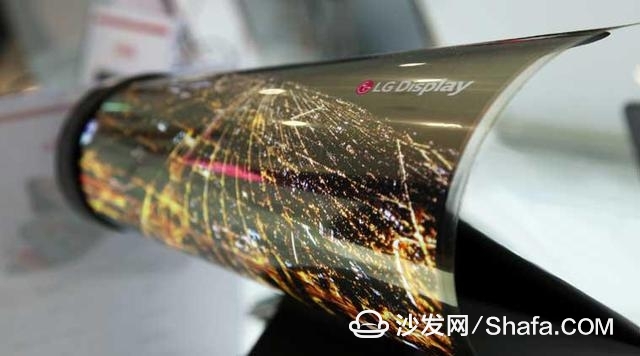As technology matures, organic light-emitting diode (OLED) panels are gaining more and more attention. The next-generation iPhone will use OLED screens to detonate this wave of OLED panel expansion. In addition to the two major Korean factories that had earlier placed OLED cloth heavily, there are Sharp's blessings from Rich Dad are equally interested in contending, but in recent years, the rising Chinese panel makers have not planned to spare OLEDs in addition to opening up LCD production capacity, and have actively invested in AMOLED production lines.

The Chinese factory not only opened the 10.5 generation and 11 generation TFT-LCD production lines, but also did not want to miss the new OLED technology. China's domestic panel makers OLEDs mainly focused on active organic light-emitting diodes (AMOLEDs). Panel maker BOE announced on the evening of the 30th that it had signed the sixth-generation flexible AMOLED production line project with Mianyang City, Sichuan's second largest city on the 28th. The Investment Framework Agreement will set up a company in Mianyang City. According to the announcement, the registered capital will be RMB 26 billion. Officially, it is expected that the second quarter of 2017 will be officially started at the latest and will be officially put into production in 2019. The preliminary plan will lock in high-end small and medium-sized enterprises. Size flexible AMOLED product applications.
BOE is not alone in the AMOLED layout. In February of this year, it announced the signing of the second phase project of the Chengdu 6th Generation Line Plant. It is estimated that the total investment amounted to 46.5 billion RMB, which is the largest historical investment for BOE Group. The official expects Phase 1 and Phase 2 to be successively Launched in 2017 and the second quarter of 2018, targeting flexible AMOLED small and medium-sized panels, the total final production capacity will reach 48,000 glass substrates per month, aiming to be applied to high-end smart phones and wearable devices.
The 5.5-generation production line newly built by BOE in Ordos in 2011 had a production capacity of 0.4 million AMOLEDs. However, as of June this year, small-lot production of hard AMOLED panels was reported. The development can be said to be slow. In addition to the two 6th-generation Chengdu line and the 6th generation Mianyang line, the future BOE OLED production line may look at four.
China's earlier investment in AMOLED's Hehui Optoelectronics began volume production of hard AMOLED in 2014, becoming the first few manufacturers to break the monopoly of Korean factories and successfully producing AMOLED panels. The monthly production capacity of Hefei Shanghai 4.5-line plant AMOLED is approximately 15,000 glass substrates. , And plans to switch to flexible AMOLED panel production at the Shanghai plant. The production capacity is expected to be released in the second quarter of 2017. In September this year, Hehui also announced that it will hold RMB27.278 billion for the construction of the 6th generation AMOLED plant, scheduled to be trial-produced by the end of 2018. , Volume production in 2019, planning monthly capacity of 30,000 glass substrates, also targeting small and medium size panels.
Compared to the just-started Chinese factory, South Korea’s Samsung Display and LG Display have successfully deployed mass-produced flexible OLED panels for 10 years, laying a solid technical barrier. Samsung’s current market share in small and medium sized OLED panels More than 90%, Samsung and LGD plan to actively expand production. Even with the production of key process equipment for OLEDs, which is the most difficult to obtain, Samsung has already made a large number of orders to a nearly monopolized equipment supplier Canon Tokki. It is reported that an OLED key splashes. The annual output of the machine platform is only three or four.
Sharp, which is under Hon Hai’s blessing, also announced in March this year that it will develop OLED panel business with a total amount of 200 billion yen. In September, it will set up multiple OLED panel test production lines at the Osaka, Osaka, and Miyamachi, Mie Prefectures.

Compared with Japan, South Korea, and Chinese mainland manufacturers, China Taiwan has seen a much slower pace of OLED development. Even if AUO is an early OLED mass production front panel maker, it concentrates on small and medium sized boutiques and takes a round cut. The route, and is expected to mass produce flexible AMOLED in 2017, but the production capacity is still small, and there is no large-scale OLED investment plan.
In August of this year, China’s Taiwan region announced that it would invest NT$100 billion to establish a soft AMOLED alliance. However, it seems that integration is still difficult. When South Korean manufacturers build high-tech walls and Chinese companies aggressively push forward, according to statistics from IHS, the mainland's LCD production capacity in the second half of the year will surpass China's Taiwan region and become the second largest in the world. Are we ready for the OLED war?
Smart TV/box information can focus on smart TV information network sofa butler (http://), China's influential TV box and smart TV website, providing information, communication, TV boxes, smart TVs, smart TV software, etc. Answering questions.
Expanded Ptfe Properties,Eptfe Gasket Sheet,Eptfe Sheet Roll,Expandable Ptfe Sheet
Cixi Congfeng Fluorine Plastic Co.,Ltd , https://www.cfptfeseal.com